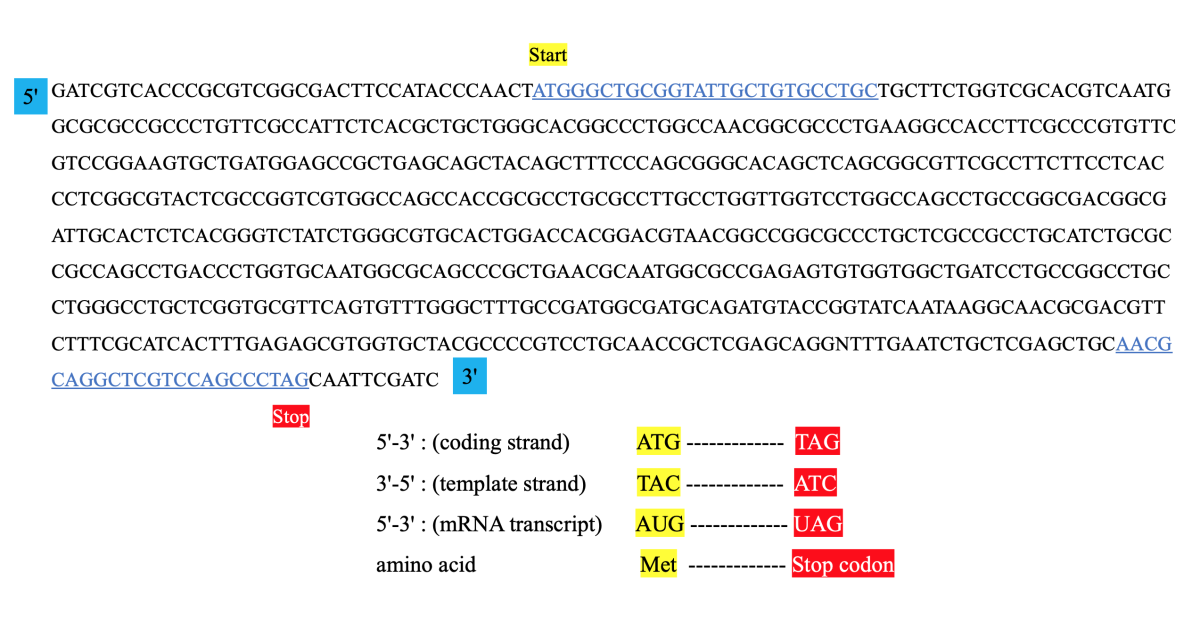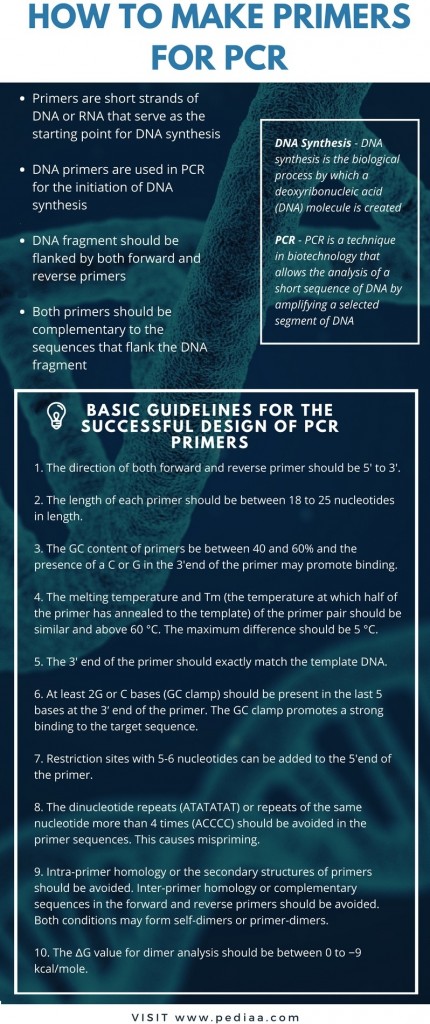Table Of Content

The option "Primer must span an exon-exon junction" will direct the program to return at least one primer (within a given primer pair) that spans an exon-exon junction. You can also exclude such primers if you want to amplify mRNA as well as the corresponding genomic DNA. The structure of the primer should be relatively simple and contain no internal secondary structure to avoid internal folding. One also needs to avoid primer-primer annealing which creates primer dimers and disrupts the amplification process.
Table 3
They include the RefSeq mRNA database and RefSeq genome database, which, as of Nov 18, 2011, contain 226 and 7,546 organisms, respectively. These databases are non-redundant as they don’t have the same sequence regions covered more than once, thus allowing better specificity checking. They are the databases of choice for designing new target-specific primers. The traditional nr database, containing redundant entries, is also available and is mostly recommended for organisms that are not covered by other databases or for sequence entries not covered by the RefSeq databases. Examples of potential unintended targets for primer pairs generated by QuantPrime and PRIMEGENS.
Calculating Melting Temperature (Tm)
Subsequently, the lagging strand can’t be replicated in a unidirectional manner (i.e. following right behind the helicase). This means that the DNA polymerase must replicate in the opposite direction (i.e. 3′-5′ because the strands have opposite directions). The DNA polymerase could technically wait for the lagging strand to be completely separated from the leading strand and then commence replication from the 3′ end of the lagging strand.
Tips and Considerations for Sensitive PCR Assays

As shown in the figure, a PCR product of the expected size (2098 bp) appears starting at a Mg2+ concentration of 2.5 mM (lane 6) with an optimal concentration at 4.0 mM (lane 9). The recommended concentration provided by the manufacturer was 1.5 mM, which is the amount provided in typical PCR buffers. Perhaps surprisingly, the necessary concentration needed for product formation in this experiment exceeded this amount. Understanding the function of reagents used on conventional PCR is critical when first deciding how best to alter reaction conditions to obtain the desired product.

Designing highly multiplex PCR primer sets with Simulated Annealing Design using Dimer Likelihood Estimation (SADDLE)
This article demonstrates how to design primers (forward and reverse) for different types of cloning methods. Other options, including parameters for BLAST search sensitivity, SNP exclusion and primer properties, etc. can be found under the “advanced parameters” section. To begin the synthesis of a new DNA strand, a short fragment of DNA or RNA known as the primer, must be created and paired with the template DNA strand before the Taq polymerase enzyme can begin the actual process of synthesizing the new DNA strand. PCR has become an indispensible tool in the biological science arsenal. PCR application is limited only by the imagination of the scientist that wields its power. There are many books and papers that describe new specialized uses of PCR, and many more will be developed over the next generation of biological science.
Design and validation of Dolosigranulum pigrum specific PCR primers using the bacterial core genome Scientific ... - Nature.com
Design and validation of Dolosigranulum pigrum specific PCR primers using the bacterial core genome Scientific ....
Posted: Fri, 14 Apr 2023 07:00:00 GMT [source]
This page demystifies the mutate-map-rescue pipeline experimental setup. The next sections take you through each of the options in the tool and explains what to set for each one and why. Click on the name and on the next screen, you will see a link to “Pick primers” in the right-hand corner of the screen underneath “Analyze this sequence”. Click on your gene of interest and scroll down until you find the NCBI Reference Sequence (RefSeq) for your gene (e.g. “NM_203483”).
Standard 3-step PCR cycling include denaturation of the template DNA, annealing of primers, and extension of the target DNA (amplicon) by DNA polymerase. All three experiments illustrate that when Mg2+ concentrations are too low, there is no amplicon production. These results also demonstrate that when both the cycling conditions are correctly designed and the reagents are at optimal concentrations, the PCR experiment produces a discreet amplicon corresponding to the expected size. The results show the importance of performing PCR experiments at a sufficiently high stringency (e.g., discreet bands versus a smear).
Primer-BLAST also supports placing primers based on exon/intron locations and excluding single nucleotide polymorphism (SNP) sites in primers. Generally, in the face of unknown pathogenic and highly infectious coronaviruses, the first step involves extracting RNA from patient samples and sequencing the whole genome. However, the whole genome sequencing operation is difficult and costly, and it is impossible to use this method for all patients with suspected infection. Genome sequencing can be used as a detection method in a few samples, and the results can be used as a reference sequence to design primers and probes targeting the target gene, so that RT-qPCR detection can be achieved. Shen et al. recently identified a remarkable level of viral diversity in some infected patients, accounting for a median number of four intra-individual viral variants, which is suggestive of the rapid evolution of SARS-CoV-2 37. With the increasing number of cases, results from genome sequencing will also increase.
Sign up and select NEB email newsletters targeted to your research
Genome sequences of multiple coronaviruses can be compared to determine the reference sequence. For primer and probe design, it is more reliable and scientifically sound to select conserved regions instead of mutation sites. Each RT-qPCR run should include both external and internal controls, and laboratories are encouraged to participate in external quality assessment schemes that should be established as soon as possible to monitor analytical quality and harmonize the assays. In many studies 34,44, the internal control primer set targeted the human ribonuclease P (RNase P) protein. This protein is an ubiquitous enzyme in all cells and cellular compartments 72.
By default, tables of the forward and reverse primers and a list of compatible primer pairs are returned, but additional outputs can be selected. Users can learn more about each parameter by clicking on the user-guide download link within the Online Help tab of the Features section. Users can also email queries or suggestions to the address contained within the Contact section or enter their email address to receive notifications of updates. The candidate primer pairs are then subject to the specificity checking process. To solve this problem, we observe that any primer is essentially a sub-region of the PCR template and a single BLAST result using the template as a query should contain alignment information for all primer pairs. As a result, when a user supplies a template sequence to design new primers (the template case), the template itself is submitted for a BLAST search just once, which greatly reduces the total search time.
As shown in Table Table2,2, most of the probes do not start with a G base except for that for the N gene developed in Hong Kong. Usually, degenerate primers are designed in two different instances. The first is when the target sequence is unknown or presents variability.
Some primers and probes have also been made available on the WHO website for reference. However, no previous review has systematically compared the previously reported primers and probes and described how to design new primers in the event of a new coronavirus infection. This review focuses on how primers and probes can be designed methodically and rationally, and how the sensitivity and specificity of the detection process can be improved. This brief review will be useful for the accurate diagnosis and timely treatment of the new coronavirus pneumonia.
This buffer region, of ~10 – 15 bases ensures that the whole RNA sequence of interest can be read out adequately in an electrophoresis experiment. This 5´ buffer region also needs to be added to the DNA template, and will also be transcribed into RNA. In the biological sciences there have been technological advances that catapult the discipline into golden ages of discovery.
Zymo Research’s DNA Clean & Concentrator Kits are capable of maximizing DNA concentration and removing contaminants, making your PCR product suitable for even the most sensitive downstream applications. The maximum number of PCR targets (amplicons) to be shown when checking specificity for pre-designed primers. This will limit the primer specificity checking to the specified organism. It is strongly recommended that you always specify the organism if you are amplifying DNA from a specific organism (because searching all organisms will be much slower and off-target priming from other organisms is irrelevant).
Use the 'helper' plate to fill in wells that do not use a 'mutant' primer (present on the plate). Please make sure that the sub-pools overlap, and each sub-pool consists of even number of primers. The '2-Round' strategy attempts to assemble sub-pools of 'half' of the full sequence, and extend the 'half' pieces together in a second round PCR. This might be helpful when there are mispriming sites across the sequence, and partitioning them into separate pools avoid such issues. To save your cart and view previous orders, sign in to your NEB account. Adding products to your cart without being signed in will result in a loss of your cart when you do sign in or leave the site.


No comments:
Post a Comment